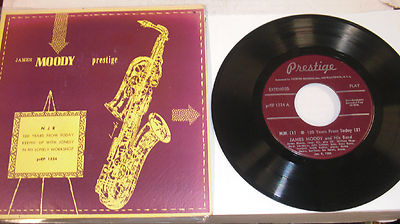But more than anything that happened in front of the mike, this session is notable, even historic, for what was happening on the other side of the mike. This was the first Prestige recording session to be engineered by Rudy Van Gelder.
Rudy Van Gelder can be said to be the first person to take the craft of recording modern jazz seriously. He made it clear from the start that he was not a producer, he was a recording engineer. He didn't choose the musicians or select the tunes or run the rehearsals (well, this was Prestige, so there were no rehearsals). His job -- the job he invented for himself -- was to make musicians sound on record the way they sounded in the studio. He worked with the musicians, to get the sound that they wanted.
Van Gelder had begun engineering sessions for Blue Note the year before. By the end of the decade, he would be the go-to guy for every jazz label.
Rudy Van Gelder first became interested in sound recording at the age of 7, when he acquired a $2.98 home recording machine, and from there, he began tinkering, improving, making his own recording devices. He went to school for optometry, and began his practice in 1942, at the age of 18. All through the fifties, as he was becoming the most acclaimed sound engineer in the business, he continued to support himself as an optometrist. But his heart was always with sound recording. By 1946, he was already recording local musicians, and when his parents were building a new house in Hackensack, New Jersey, he asked his father if they would include a living room that would double as a recording studio.
I'm trying to picture asking my father to do something like that. In the first place, I can hear him saying "Look, you're finally making something of yourself as an optometrist. It's a living. Stick to that." In the second place, a living room is a fairly important part of most people's houses, and it's generally built around entertaining, displaying tchotchkes, and generally being a space that the neighbors would admire. But as Van Gelder remembers it, in an interview with Marc Myers of JazzWax,
When my father was having the blueprints done, I asked him if I could have a control room with a double glass window next to the living room. I wanted to perfect the techniques of contemporary music recording.Exactly what Van Gelder did to capture the essence of a musician's sound was his secret, and pretty much remains his secret today. It's said that he would put dummy mikes up around his studio, so that no one ever knew exactly which mikes were live for a recording. He was the first to use a German-made Neumann condenser microphone, which had a sensitivity that enabled the capturing of subtleties of sound.
JW: How many months of begging did it take?
RVG: None. My father agreed immediately. He knew how passionate I was about the music and the process of recording. Passion mattered to both my father and mother.
JW: What did you tell your father—or the architect?
RVG: I asked that the living room be as large a space as possible, within the footprint of the house. My father’s architect decided to accomplish this by making the living room ceiling higher than the rest of the house, which made for great acoustics.
In March of 1952, Van Gelder recorded saxophonist Gil Mellé for an independent label that never got off the ground. But the masters of the session were brought to Alfred Lion at Blue Note. He liked Mellé's sound and decided to record him, but none of his attempts sounded anywhere near as good. So Lion decided he needed to meet the engineer who had done the original session.
And the rest is history. Van Gelder recorded Mellé for Blue Note in January of 1953, and everyone in the industry listened to that record the way they had listened, in 1942, to Charlie Parker's solo on the Jay McShann orchestra's recording of "Sepian Bounce" -- with the knowledge that a door had been opened that would never be closed again.
These were released on two 78s, on a 45 RPM EP, and on a 10-inch LP. Later, they were included on a couple of 7000-series LPs, Moody and Moody's Workshop.
A complete index to musicians covered in this blog here.



No comments:
Post a Comment